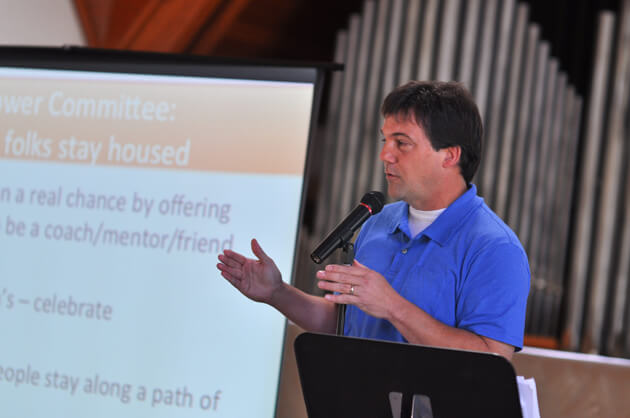 Survey Results Provide Window Into Santa Barbara County’s Homeless
Survey Results Provide Window Into Santa Barbara County’s Homeless
The findings of Common Ground Santa Barbara shed light on the age, gender, income and even mortality risk of those on the streets

The demographics of Santa Barbara County’s homeless population got much clearer Monday, after results were released of a survey done earlier this year.
More than 500 volunteers administered surveys of the county’s homeless in March, and 1,143 were completed. The effort, spearheaded by the group Common Ground Santa Barbara, is part of a larger national effort to house the nation’s most vulnerable.
A news conference was held Monday morning in Los Olivos to go over the results, led by Rob Fredericks, deputy executive director and chief administrative officer at the Housing Authority of the City of Santa Barbara and the leader of Common Ground Santa Barbara, as well as a handful of other officials.
Click here to view the results.
One of the most staggering results was that nearly 80 percent of those surveyed were classified as vulnerable with a high mortality risk. The survey classified people as vulnerable if they had been homeless for more than six months as well as the presence of one or more health related factors, such as having liver disease or HIV/AIDS.
A snapshot of the homeless on one night found that there were 1,782 unduplicated individuals throughout the county.
Of all the locations in the county, the highest number of surveys was completed in Santa Barbara, with 1,040 total, and some of the basics of the data paint a much more vivid picture of the homeless.
According to the survey, 73 percent of the respondents were men, with 27 percent women, on par with the national average. Veterans made up 15 percent of those surveyed.
The average age of those surveyed was 41 years old. Respondents ranged in age from as young as 12 years old to 78, and the majority were white. The average time of homelessness was seven years.
The survey also asked about income, and nearly 22 percent said they rely on food stamps for their main source of income. Fourteen percent said they relied on panhandling.
The living situation of the homeless also shed some light, and 31 percent of those surveyed countywide reported that they live in shelters. That number was followed closely by those who said they live on the streets, and 15 percent said they live in their vehicles.
One of the most controversial parts of the discussion surrounding homelessness in Santa Barbara is whether locals should be given first priority for services.
The survey showed an almost even split between where people were located before becoming homeless — 28 percent said they were located in South Santa Barbara County before being homeless, 23 percent said they were in North County, and another 44 percent were nearly evenly divided between being located in another part of California or out of state.
Of people who said they had relocated to Santa Barbara County, nearly 19 percent said they moved here because of family in the area. Services rated the lowest, with only 5 percent of respondents relocating because of that.
Another startling statistic revealed that 77 percent of those surveyed had spent some time in jail. A quarter of those surveyed had spent time in prison. The survey didn’t ask how long respondents had spent in jail or prison, but based on average stays, the cost of incarcerating those surveyed amounts to nearly $14 million.
Another cost breakdown was provided in the results. A total of 326 emergency room visits were reported, with another 405 hospitalizations annually, costing nearly $3 million.
In addition, 134 surveys were given to families, 97 percent of which are considered vulnerable. More than half of those respondents said they were victims of domestic violence. Also included in the surveys were 221 children, and 16 were deemed to have a serious medical condition.
High rates of mental illness and substance abuse were reported. Both chronic conditions and infectious diseases were also common. During this year’s homeless count, 520 people were identified as severely mentally ill and 735 had chronic substance abuse issues.
Fredericks said there’s a lot of work ahead for local agencies, and the group has set a goal to house 100 people from among the most vulnerable identified by the survey within the next year.
“It’s going to take a real group effort, but we think we’ve got a good chance of doing this,” he said.
Among the strategies to house more people is to get 100 faith congregations in the county to help. The group will be asking each congregation to raise funds that will provide a rental subsidy to house people on the list.
The group also will be updating its website with a quarterly progress update.
Fredericks also said the group has been able to house seven of the people surveyed, and are getting ready to house an eighth.
“It’s somewhat coincidental,” he said, “but it also goes to show that we have mechanisms in place already to house people who are in need.”
— Noozhawk staff writer Lara Cooper can be reached atlcooper@noozhawk.com. Follow Noozhawk on Twitter: @noozhawk or@NoozhawkNews. Become a fan of Noozhawk on Facebook.
